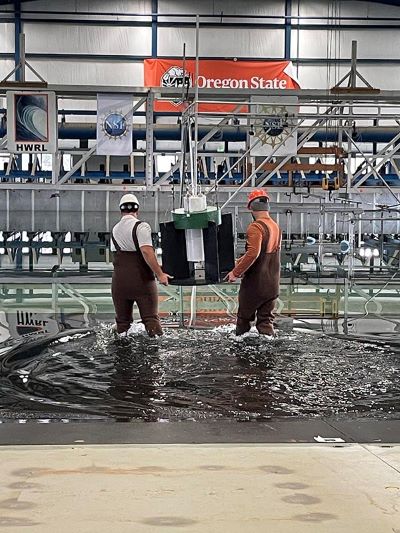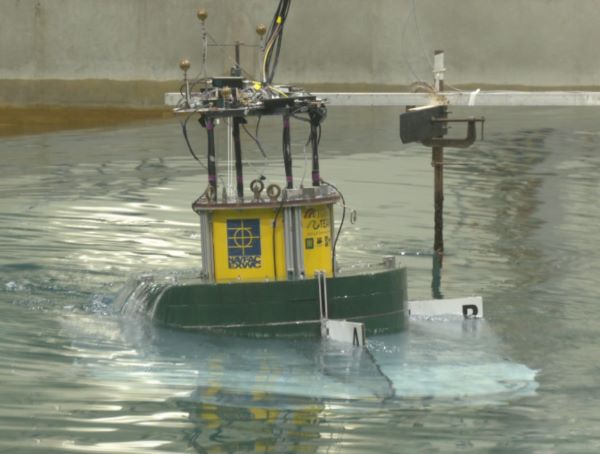The Testing Expertise and Access for Marine Energy Research program is helping the University of Hawaii test a wave-powered ocean observation platform and breakwater.
Water Power Technologies Office
January 15, 2025This is part three of a series of articles highlighting projects advanced through the U.S. Testing Expertise and Access for Marine Energy Research (TEAMER) program. TEAMER provides marine energy technology researchers and developers with streamlined access to U.S.-based test facilities and world-class technical expertise. Since TEAMER launched in 2020, the program has supported more than 160 marine energy physical testing and numerical modeling projects with more than $18 million in technical support.
Marine energy is still a relatively young field and using just one-tenth of the available marine energy resources in the United States could power 22 million homes. Accessing funding, expertise, and locations for testing can be difficult for technology developers. In 2020, the U.S. Department of Energy (DOE) launched the TEAMER program to help overcome these barriers and advance the viability of marine energy. Sponsored by the Water Power Technologies Office (WPTO) and directed by the Pacific Ocean Energy Trust, TEAMER offers developers and researchers the opportunity to test and refine their marine energy technologies at a range of facilities in the TEAMER Network.
TEAMER’s support allowed the University of Hawai’i (UH) to advance two oscillating water column (OWC) technologies. An OWC is a type of wave energy converter (WEC) that harnesses energy from waves. It uses the power of waves, funneled into an open chamber, to pressurize air. That pressurized air then spins a turbine and generates electricity.

Drawing Inspiration from Nature
UH first tested an OWC designed to support autonomous underwater vehicle (AUV) docking and charging capabilities. The device, known as Project Hālona, was based on a prominent coastal feature on the island of Oahu known as the Hālona blowhole. The blowhole has unique geologic properties and takes incoming waves and magnifies them through a hollow chamber into a geyser.
“Think of the core of the device being a straw floating vertically in water. The internal water surface in the straw reverberates because of how the wave is restricted at the bottom opening,” says Nicholas Ulm, UH PhD student and founder and CEO of Hawai’i Ocean Power Solutions LLC (HOPS).
“It’s similar to the effect you get when you roll down a window on the highway and hear the reverberation in your ear. If you constrain any wave into a chamber of a certain size, you will cause a resonant pressure. We are trying to induce that resonant effect, but in our case, we’re using the water surface inside a straw as a kind of piston to compress air through a turbine system above the water,” he explains.
Project Hālona is designed to power ocean observation platforms or AUVs that support various ocean observation applications such as collecting data to monitor and predict hurricanes. The AUVs this device is designed to support will be equipped with sensor equipment to measure ocean characteristics like current velocity and temperature that can be uploaded to Hālona.
Many wave energy devices emphasize extracting the most amount of power from the ocean to generate electricity for power grids, but in the case of ocean observation applications, the priority becomes how much power is needed to charge ocean observation platforms or AUVs. Consequently, Hālona was designed to minimize motion and maximize stability to enhance AUV docking while still providing adequate power to enable charging.

Powering Scientific Exploration through Wave Energy
Much of Hālona’s design and testing would have been impossible without TEAMER. The project began with numerical modeling and testing at UH’s Applied Research Laboratory, but when testing in a larger wave basin became necessary, TEAMER was able to support the team with access to Oregon State University’s (OSU) wave basin. There, UH was able to test how a 1:10 scale model of Hālona would perform in multiple wind and wave conditions. A later round of TEAMER support enabled researchers to conduct a 1:4 scale model test at Texas A&M’s Offshore Technology Research Center’s wave basin, where the team looked at the geometry, weight, and mooring options for the device in a way that would have been impossible at UH.
The ability to charge AUVs generated interest from the U.S. Navy’s Naval Facilities Engineering Command, which provided additional non-TEAMER funding to the UH team and will provide access to open water test locations, such as the Wave Energy Test Site (WETS) in Hawai'i. WETS is the United States’ first grid-connected wave energy test site that helps companies test pre-commercial technologies in the water to advance their technological readiness level.
The growing success of this project led Ulm to take Hālona from a technology concept for his dissertation and launch his own company, HOPS. Most recently, Ulm led a TEAMER proposal with HOPS for modeling support from the American Bureau of Shipping (ABS) to test whether an updated Hālona design could recreate the previous TEAMER test results numerically.
“TEAMER has been absolutely critical to my dissertation and my career success,” said Ulm. “TEAMER has provided us with opportunity to demonstrate how wave energy can scale and given us access to high quality research and facilities.”
Combining Wave Energy with Infrastructure to Protect Shorelines
UH is also working on a second OWC system that functions as a breakwater to protect shorelines from tides and storm surges. The concept—a curtain pile breakwater—is a partially open structure with spaces between its vertical components. This design can both help reduce construction costs and be environmentally beneficial when compared to other breakwaters because it allows water and marine life to naturally flow between the harbor and the ocean unobstructed. A number of OWC chambers are then added at length to the top of the structure above the waterline for energy extraction.
“If we’re building breakwaters in the world due to sea level rise and coastal mitigation needs, why not integrate wave energy extraction into such a structure?” asks Patrick Cross, director of the Hawai'i Marine Energy Center and ocean energy program lead at the Hawai'i Natural Energy Institute. “And why not integrate OWC modules into it for power extraction?”
Breaking Water and New Ground
The five-person team first tested the design in a small lab wave flume (a narrow wave tank that enables close study two-dimensional waves), but soon needed larger-scale testing to move the idea forward. Funding from the Navy is now enabling them to build 10 one-meter-width OWC chambers that will be tested at the OSU wave basin in early 2025 with support from TEAMER. One module will be equipped with a functioning turbine, while the others will simulate the effects of the power take-off (the mechanism for absorbing and converting wave energy into electricity) with orifice plates (a plate with a circular hole in it allowing air to flow through as waves hit the structure). By measuring the pressure difference on sides of the orifice plate, the team can calculate the power production without needing a turbine. The testing will help the team learn how well the breakwater functions and better quantify the power production capability of the OWCs.
“TEAMER has been an outstanding augment to other sources of funding for larger-scale testing,” said Cross. “We've got a burgeoning research team here at University of Hawai'i, but we do not have the facilities of an Oregon State or Texas A&M. We’re limited to small flumes that can get us started on a concept, but don’t compare to the basin and flume scales available at other facilities. The team at Oregon State has outstanding professionals with extensive experience in marine energy testing and are great to work with. One of the stars of the TEAMER network.”
Looking Toward the Future
The team behind Hālona is now looking toward its next steps, including working with ABS again to review previous work for a new technology qualification that could help the team move closer toward commercialization.
UH is also looking to collaborate with HOPS to build a larger Hālona prototype for ocean testing in Hawai'i. This prototype will be integrated with an experimental power take-off system. Once successfully tested, the power take-off system will also be used in the OWC breakwater system.
Read about how TEAMER also helped E-Wave Technologies and the University of Washington advance marine energy technologies.
Interested in partnering with marine experts at world-class facilities to hone and develop your marine energy device? Learn more about requests for technical support through the TEAMER program.
Stay in the know with WPTO! Receive the latest information on funding opportunities, events, and other news by subscribing to the bimonthly The Water Column newsletter, as well as the comprehensive, monthly Water Wire newsletter.

